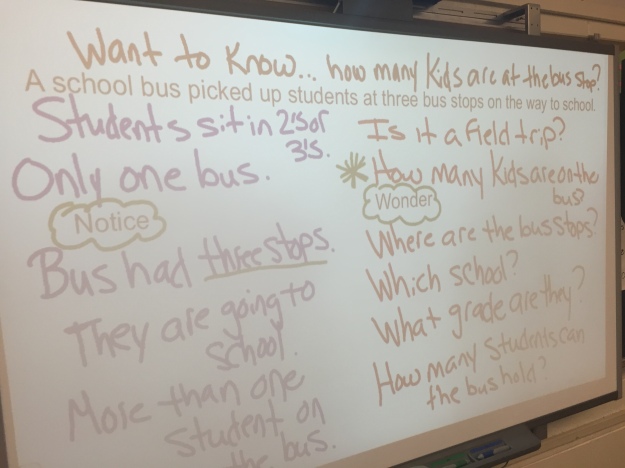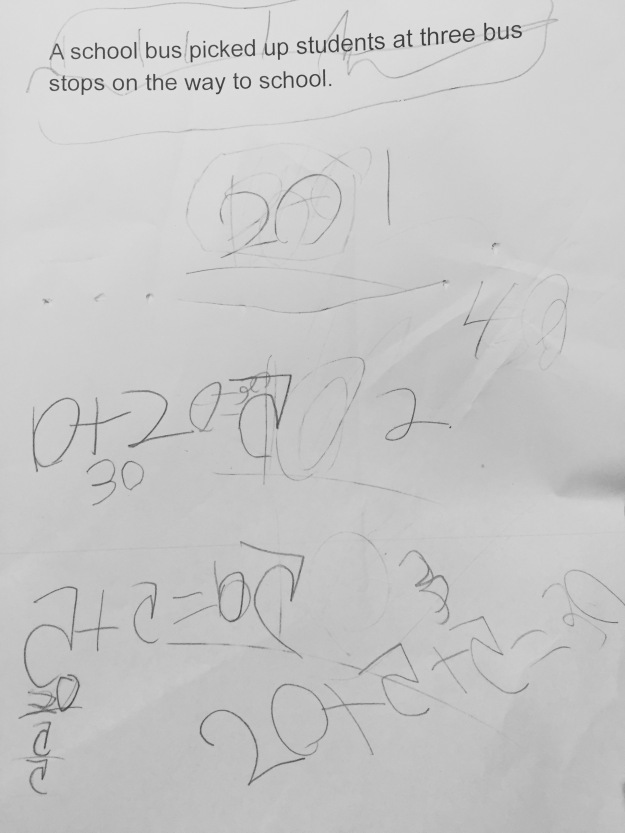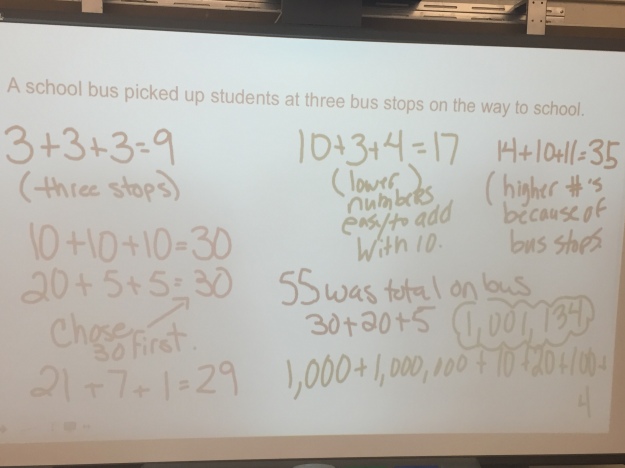Yesterday, I had the chance to teach the 1st grade lesson I planned here. It was so much fun and SUCH a learning experience for me! After all of the conversation in the comments and on Twitter, I decided to start with the open, one sentence Notice/Wonder. Only having 45 minutes and this being the students first time doing a N/W, I decided not to begin with a number talk/routine (which I usually always do).

The students started on the carpet, I put up the sentence, read it and asked, “What do you notice and wonder about this sentence?” Just then a student exclaims that he just noticed that “Notice” was not, “Not Ice.” At that moment, I began thinking maybe my question had them looking at the physical pieces of the sentence/words so I quickly rephrased, “I would love to hear what you notice and wonder about what is happening in the sentence.” They used their Number Talk signals, thumbs up when they had a notice or wonder and then used their fingers to indicate more than one. I was so impressed by all of their thoughts, but I did realize that is it hard to end their wonderings! The amazing thing was how all of their wonderings really could turn this sentence into a story in their ELA class because they were all really important details they could add to it. Here was how the board ended.

I asked which wonder we could work on together today in class and there was a unanimous vote for “How many kids are on the bus?” however there were a few that suggested, “How many student can the bus hold?” because “math is counting things and we could count the seats.” I starred the wonder “How many kids are on the bus?” and told them next time they get on their bus I would love to hear how many seats and students they found are there. We discussed whether they know how many students were on the bus by reading our sentence and they said no, they only know that there were 3 stops. I asked, what they would want to know and they wanted to know how many kids were at the stops. I wrote that at the top.
When I told them they would get to choose how many students were at each stop, they were so excited! I gave them a paper with the sentence at the top, let them choose a partner and sent them on their way.
As I walked around and asked students why they chose the numbers they did, I quickly wondered how much I should have helped organize their work for them. I found so many with numbers everywhere and it was hard to see where their bus stop numbers were, let alone their total. Should I have put Bus Stop 1____, Bus Stop 2____, and Bus Stop 3_______ to have a clearer picture while also modeling for students how we can make our math work more clear? Quite a few looked like this…

There were so many interesting papers, so I love WordPress’ new tiling feature for pictures to make it look less cumbersome!
Top Row, Pic 1: This student had 24 as two stops. When I asked him how many stops we noticed in the beginning, I got a “Oh gosh” and he wrote Bus stop 1, 2, and3. He then stuck with the 24 and when I came back he had 8, 8, and 8. I didn’t see this until after class so I am curious how he arrived at that answer. I also realized that these 1st graders move fast and it is SO easy to miss the cool things they do so quickly!!
Top Row, Pic 2: They said 3 and 22 were easy to add and then they just chose another small number. The interesting thing here that I need to find out more about is the 5×6 with the one box shaded in. I loved the commutativity showing up here!
Top Row, Pic 3: This was so interesting because I had never thought that a student would first think of how many students were on the bus and divide it up from there. They thought 30 students would fit on a bus so they made the stops fit that information. (They saw the error on the last one during the share).
Bottom Row, Pic 1: This student said that because there were 3 stops, there were 3 students at each one and ended with 9.
Bottom Row, Pic 2 &3: This student wanted big numbers so his first response, after he insisted on re-writing the sentence, was 1,000 and 1,000,000 and 4. Then on the back of his paper he wanted 6 stops and chose 6 new numbers. This led to some great conversation during the share.
This student figured that if there were 1 or 2 at a seat then there would be 55 students on the bus. I love all of this work so much! Then when I asked her about the students at each stop, she said, 30, 20 and 5.

We shared as a group back on the carpet and I tried to capture why they chose the numbers they did:

I then gave them the original problem and asked them to solve it individually. After seeing them work on this problem, I think there are so many interesting conversations that could happen Monday morning!
This is where I had so many questions as to how we get the younger students to make their thinking more visible. I found so much of it happens on fingers, 100s chart, and number line on their desk that I was getting an equation on the paper. It is great when I am sitting there asking, but that cannot obviously happen when they are done so quickly and there a bunch of them! Is this something that comes with practice? I did find that once I asked them if they could explain to me on the paper how they solved it, they did a great job. My next question is, would taking the 100s charts and number lines off the desks help push students to look for friendlier numbers? I found the majority of them went left to right, counting on instead of using the 6 and 4 first. This is something that I think a structured share out on Monday could bring to light for those who never thought of it.
Here are a sampling of the papers I look forward to chatting with the teacher, Lisa, about on Monday. We can chat about how we can structure this share out.
Lisa, through number talks and investigations, has been working a lot on having students noticing number patterns leading to generalizations. It was neat to see this work of adjusting addends and keeping the same sum showing up here too. It seemed to show up most after they had their answer and were playing around with the numbers, which I love!!
I am happy to have started with the open notice/wonder because I learned so much about how they think about problems and I think the opportunity to choose their own numbers got them thinking about the context over solving for an answer to an addition problem. I am, however, extremely curious how it would have changed the work if I had given students the problem with the 13 given and the other two missing? Would I have seen more about how they choose numbers to make the 13 easier to add a third number? I am hoping to get into another 1st grade classroom to try this out with another teacher but I would love it if any other 1st grade teachers would there would love to try it out and report back!!
I am so looking forward to Jamie’s post on this because her student work looked amazing on Twitter yesterday!!
~Kristin
Yeah, Jamie’s post is up! Check it out here! Cannot wait for our Google Hang Out tomorrow to chat all about it!















I love this idea! (The notice/wonder with a non-specific problem). I teach 7th graders and I could definitely use this to help spark their problem solving abilities. They HATE solving problems, but this (letting them choose #s for the problem) makes it seem so much more fun! Thanks for sharing!
LikeLike
Yes, notice/wonders are amazing for letting students think about a context w/o the hurry to jump in and try to solve it! If you have not visited The Math Forum’s website, they do amazing notice wonder work with all grades! Please be sure to cone back and share how it went!
LikeLike
I just visited The Math Forum’s website and found several helpful links to notice and wonder work. I’m really excited about doing this with my students. It has the potential to really open up children’s mathematical thinking. Thanks so much for sharing this!
LikeLike
You might also like Annie’s ignite talk too: http://youtu.be/lz7aELjGy_Y She is Math Forum peeps!
LikeLike
I am wondering how I can take this problem and rewrite so that it has larger numbers for my fifth graders. I was thinking I could change it like this: A 10-car train in NYC made 3 stops. I like the Notice and Note idea a lot. I’m definitely going to use this with my students this week. Thanks for all the wonderings and noticings in this post!
LikeLike
I meant notice and wonder. Was thinking of a book called Notice and Note.
LikeLike
That is an awesome idea Elisa! The interestinh part with the train is you would have to assume no one got off…hmmm…but that may lead to some seriously interesting wonderings! What are your thoughts on that?
I work closely w/my reading specialist so I hear notice and note all of the time!! 😉
LikeLike
Good point about no one getting off. I was just thinking about the notice and wonder part at that point. Immediately after I commented, I realized that the problem was incomplete. I will revise the problem so that there are some people in each car at the beginning, and a total number of people get off at each stop. I’m going to see if I can find out how many seats there are on a NYC subway car. Of course, this doesn’t take into account how many people could actually fit standing up as well! Hmmm. Any ideas for me?
LikeLike
I am wondering if something as open as “The Smith family is driving from Lewes, DE to San Antonio, TX for the holidays. They have decided they will make three stops along the way. Would that get at high mile numbers you think?
LikeLike
I really love how open your notice/wonder was. I totally agree about the correlation to language arts. I actually started a blog about that, but haven’t finished it yet. It probably is a good idea to help these little ones structure their work a little bit, I do that with their math journals too. What helps me understand their thinking, aside from talking to them of course, is their choice of tools. This gives me a good chunk of time to watch and listen. I can’t believe you got through the whole thing in 45 minutes! I love the idea of beginning the next school day with the work from the previous day! I think that time away gives students more time for processing everything they’ve experienced. I’m that way myself. When I learn new things from Ryan I kind of need to wrestle with it and sleep on it, then for whatever reason I “get it.” I wish I could keep going with this myself. 🙂 I look forward to our chat on Monday! Thanks for all you do!
LikeLike
Great that you went with the numberless Notice/Wonder at the start, Kristin! And what fine observations you got. (It’s interesting that lots of them aren’t mathematical, but it’s all helping them to visualise and interrogate the situation, so that it all makes sense.)
It was good that it didn’t preclude the possibility of then giving a more number-based stimulus afterwards, that a second bite was possible.
It’s tricky, that balance of thinking and recording thinking. Too little recording, and it can be all gone in a flash, too much and the recording can take over, and the spring in the thinking and lesson is lost. Even more so with children this age.
This particular lesson, among other things, makes me want to work with students this age again. But at some point soon I’ll try out something similar with my Year 4s (Gr3s).
Thank you again for all your blogging this week. It’s great to be inducted into the whole process of planning and reflection, as well as the lessons themselves!
LikeLiked by 1 person
Pingback: Math Teachers at Play #92 | DeniseGaskins.com
Hello! This post was recommended for MTBoS 2015: a collection of people’s favorite blog posts of the year. We would like to publish an edited volume of the posts and use the money raised toward a scholarship for TMC. Please let us know by responding via email to tina.cardone1@gmail.com whether or not you grant us permission to include your post. Thank you, Tina and Lani.
LikeLike
Of course! That is so flattering! Thank you!
LikeLike